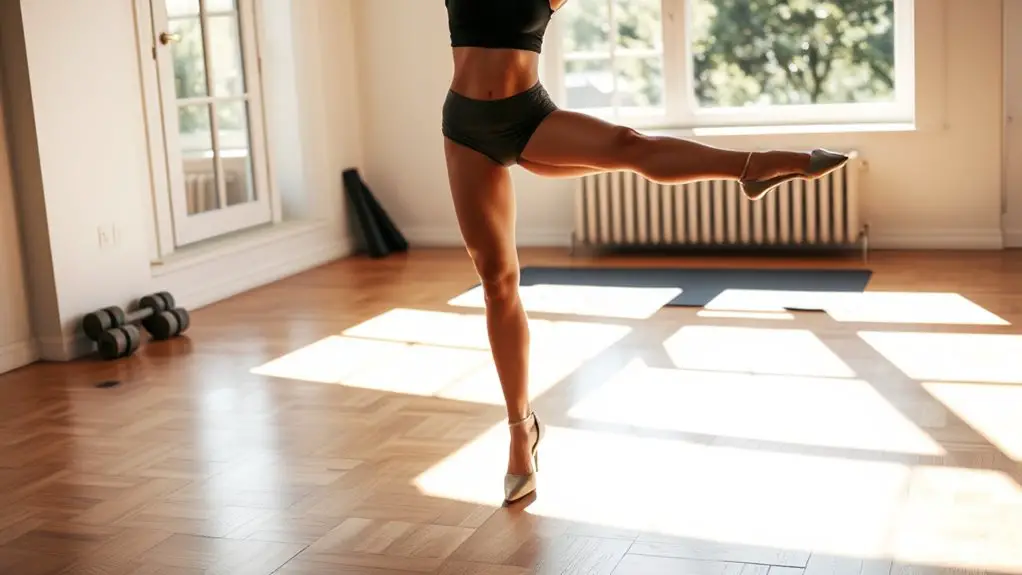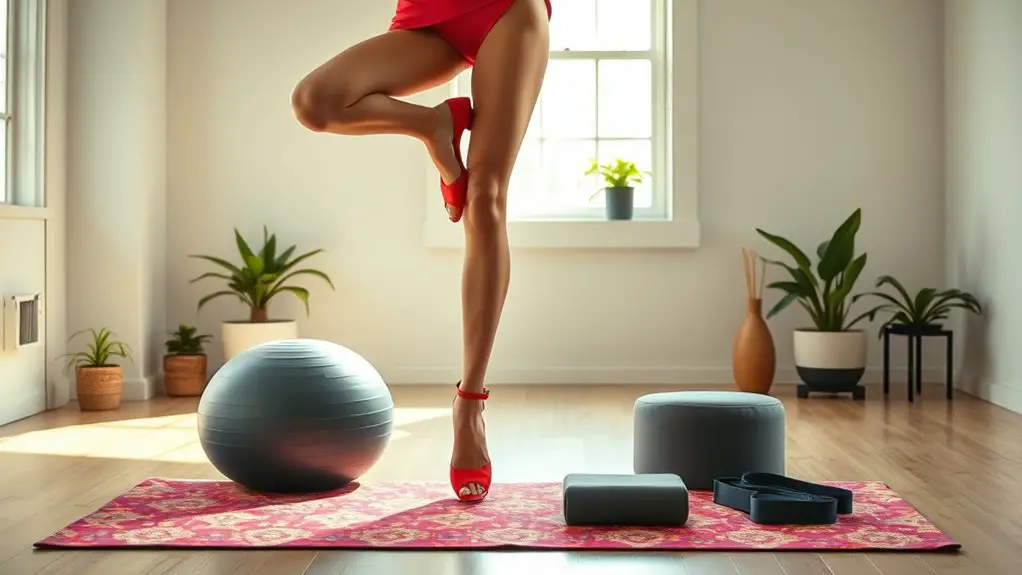To improve your balance while wearing heels, focus on core strength with planks and side lunges. Incorporate calf raises to strengthen your lower legs and enhance stability. Practice heel-to-toe walks and single-leg balancing for coordination. Yoga poses can boost your flexibility and overall balance, while Pilates builds core control. Don’t forget to challenge yourself on a balance board too. The journey to confident heel-wearing involves integrating these exercises into your routine for the best results.
Strengthening Your Core

When you’re looking to improve your balance in heels, strengthening your core is vital. Core stability is the foundation of good posture and balance, especially when you’re maneuvering the challenges that come with wearing high heels. Engaging your core muscles not only supports your spine but also helps maintain equilibrium when you’re on uneven surfaces.
To enhance core engagement, incorporate exercises like planks, bridges, and seated rotations into your routine. These movements activate your abdominal muscles and build strength in your lower back, which is fundamental for stability.
Additionally, practicing balance exercises like single-leg stands can further improve your core stability while wearing heels. By focusing on your core, you’ll find it easier to walk gracefully and confidently, minimizing the risk of slips or falls. Remember, a strong core translates to better balance, making your time in heels far more enjoyable.
Calf Raises for Stability
Calf raises are essential for building stability, especially when wearing heels. Not only do they strengthen your calf muscles, but they also enhance your balance and coordination. To get the most out of this exercise, it’s vital to use proper technique, which we’ll break down next.
Benefits of Calf Raises
Building a strong foundation is essential for maintaining balance, especially when wearing heels, and calf raises are an excellent exercise to achieve this. The calf raise benefits extend beyond just strengthening your calves; they contribute considerably to your overall stability and posture. Here’s why you should incorporate them into your routine:
- Enhanced stability: Strong calves help support your ankles, reducing the risk of falls.
- Improved posture: A solid foundation promotes better alignment when walking in heels.
- Increased strength: Regular calf raises build muscle endurance, allowing for longer wear of high heels.
- Reduced fatigue: Stronger calves can lessen discomfort and tiredness during extended periods of standing.
Proper Technique Explained
To achieve the maximum benefits from calf raises, using the proper technique is key. Start by standing with your feet hip-width apart, ensuring you maintain proper posture throughout the exercise. Engage your core to provide stability. As you raise your heels, focus on your heel height—aim for a controlled lift rather than a quick motion. Hold the position for a moment at the top, feeling the contraction in your calves. Slowly lower your heels back down, ensuring your movements are smooth and deliberate. Remember to keep your body aligned; avoid leaning forward or backward. Practicing this technique consistently will enhance your stability in heels, making it easier for you to walk confidently and gracefully.
Heel-to-Toe Walk

One effective exercise to enhance your balance in heels is the heel-to-toe walk. This exercise focuses on improving your heel placement and foot alignment, essential for maintaining stability while walking in high heels. Here’s how to do it:
- Stand tall with your feet together.
- Take a step forward, placing the heel of your front foot directly in front of the toes of your back foot.
- Focus on keeping your body straight and your core engaged.
- Repeat this motion for several steps, then switch directions.
Single-Leg Balancing
After mastering the heel-to-toe walk, incorporating single-leg balancing into your routine can greatly boost your stability in heels. This exercise focuses on engaging your core and lower body, essential for maintaining balance while wearing elevated footwear. Start with basic single-leg variations, such as standing on one leg for 30 seconds. Gradually increase the challenge by closing your eyes or adding arm movements.
You can also try single-leg deadlifts to enhance your strength and stability simultaneously. As you progress, incorporate balance challenges like standing on a pillow or using a balance board. These variations not only improve your balance but also help build the necessary muscle memory for walking confidently in heels. Remember to switch legs regularly to guarantee balanced development. With consistent practice, you’ll find it easier to navigate various terrains while wearing your favorite heels, enhancing both your style and confidence.
Side Lunges for Agility

Incorporating side lunges into your routine can markedly enhance your agility and lateral stability, both essential for confidently maneuvering in heels. These exercises not only work your legs but also engage your core, improving your overall balance. To maximize the benefits, consider adding these agility drills:
- Warm up with dynamic stretches to prepare your muscles.
- Execute side lunges by stepping out, bending one knee while keeping the other leg straight.
- Engage in side stretches after lunges to maintain flexibility and prevent tightness.
- Repeat and vary your lunging angles to challenge different muscle groups.
Resistance Band Exercises
Resistance band exercises are a powerful tool for strengthening ankle stability, which is vital when you’re wearing heels. By incorporating these bands into your routine, you also enhance core engagement, providing a solid foundation for balance. Let’s explore a few key exercises that will help you feel more secure and confident in your heels.
Strengthening Ankle Stability
Ankle stability plays an essential role in maintaining balance, especially when wearing heels. By incorporating resistance band exercises into your routine, you can enhance your ankle mobility and engage in effective proprioceptive training. Here are some key exercises to take into account:
- Ankle Dorsiflexion: Secure the band around your foot and pull it toward you while keeping your heel grounded.
- Ankle Eversion: Attach the band to a stable object, stepping sideways to strengthen the outer ankle.
- Ankle Inversion: Use the band to pull your foot inward, promoting stability on the inner side.
- Calf Raises: Stand on a step with the band providing resistance as you rise onto your toes.
These exercises will help you build a solid foundation for better balance while wearing heels.
Enhancing Core Engagement
Building on your ankle stability, enhancing core engagement is essential for maintaining balance in heels. Resistance band exercises are an effective way to improve core stability and support dynamic movements. Start with the band anchored at waist level; step back and hold the ends in each hand. Engage your core as you perform lateral leg lifts, guaranteeing your hips remain level. This activates your obliques and stabilizes your pelvis. Next, try seated rows with the band, focusing on pulling while keeping your torso upright. This strengthens your back and core, improving overall posture. Incorporating these resistance band exercises into your routine will not only enhance your core engagement but also guarantee you feel more stable and confident while wearing heels.
Yoga Poses for Balance
Incorporating just a few key yoga poses into your routine can greatly enhance your balance, especially when wearing heels. Yoga not only improves your balance but also boosts your flexibility, allowing you to navigate high heels with confidence. Here are some effective poses to include:
Incorporating key yoga poses can significantly improve your balance and flexibility, making it easier to wear heels with confidence.
- Tree Pose (Vrksasana): This pose strengthens your legs and enhances stability.
- Warrior III (Virabhadrasana III): Great for improving core strength and balance.
- Eagle Pose (Garudasana): This helps with coordination and focus, key for maintaining balance.
- One-Legged Mountain Pose (Tadasana): Builds strength in your standing leg while challenging your stability.
Practicing these poses regularly can lead to better yoga balance and increased yoga flexibility, making it easier for you to feel secure and graceful in your favorite heels. Start slow and gradually increase the duration to build your strength and confidence!
Pilates for Core Control
Incorporating Pilates into your routine can greatly enhance your core strength, which is essential for maintaining balance while wearing heels. You’ll learn stability and control techniques that not only support your posture but also improve your overall body awareness. By focusing on these core control exercises, you’ll build a solid foundation for graceful movement in any footwear.
Core Strength Exercises
While mastering balance in heels can be challenging, strengthening your core through Pilates is a highly effective method to enhance stability and control. A strong core not only supports your spine but also improves your overall posture, making it easier to navigate the nuances of wearing heels. Incorporate these core strength exercises into your routine:
- Plank variations: Try side planks or forearm planks to engage different muscle groups.
- Balance drills: Use a stability ball or balance board to challenge your core stability.
- Pilates hundred: This classic exercise builds endurance and strengthens your core.
- Leg lifts: They target the lower abdominal muscles, essential for maintaining balance.
With consistent practice, you’ll find your confidence and stability in heels considerably improve.
Stability and Control Techniques
To achieve stability and control in heels, Pilates offers targeted techniques that enhance core strength and awareness. By focusing on your core, you’ll develop the necessary support for maintaining balance while walking or standing in heels. Incorporate balance techniques like the single-leg stand, where you’ll engage your abdominal muscles to stabilize your hips and spine. Control exercises such as the Pilates “Hundred” promote endurance and coordination, allowing you to manage the shift in your center of gravity effectively. Additionally, practicing the pelvic curl helps improve lower back support, essential for maneuvering high heels with confidence. By consistently integrating these Pilates principles into your routine, you’ll build the stability needed for graceful movement in heels.
Balance Board Training
Balance board training is an excellent way to enhance your stability and coordination, especially when wearing heels. By incorporating balance boards into your routine, you can experience numerous balance board benefits, such as improved posture and core strength. Here are some effective balance board techniques to get you started:
- Basic Stance: Stand on the board with feet shoulder-width apart, focusing on maintaining balance.
- Squats: Perform squats while on the board to engage your legs and core.
- Single-Leg Balance: Lift one foot off the board and hold your balance, challenging your stability.
- Side-to-Side Rocking: Shift your weight from side to side to improve lateral stability.
Practicing these exercises will not only strengthen your balance but also make you feel more confident when strutting in heels. Regular balance board training can lead to greater agility, ensuring you’re ready for any occasion.
Stretching for Flexibility
Incorporating stretching into your routine is essential for enhancing flexibility, which is particularly important when wearing heels. Dynamic stretching, involving controlled movements that increase your range of motion, can greatly improve your balance and stability. Before you slip into those stylish shoes, consider integrating flexibility routines that target your calves, hamstrings, and hips.
Start with leg swings to loosen up your lower body, followed by walking lunges to engage multiple muscle groups. These exercises prepare your body for the demands of heels, reducing the risk of injury.
After a day in heels, static stretching will help alleviate tension. Focus on stretches like the standing calf stretch and seated forward bend to maintain flexibility. Prioritizing these practices not only enhances your comfort in heels but also boosts your overall balance and posture. Remember, a flexible body is vital for maneuvering any terrain confidently.
Frequently Asked Questions
How Long Should I Practice These Balance Exercises Each Day?
You should aim for a balance duration of 15 to 30 minutes daily. Consistent practice frequency is key; try to incorporate these exercises five times a week to see significant improvements in your stability.
Can I Wear Heels During These Exercises?
You shouldn’t wear heels during these exercises. Practicing without them enhances heel stability and reduces the risk of injury. Focus on mastering balance in flat shoes first, then shift to heels once you’re more confident.
What Type of Heels Are Best for Balance Training?
The best heel types for balance training are typically block or wedge heels, offering stability. Consider heel height; lower heels are easier to manage, while higher ones require more strength and control for effective balance training.
Are There Any Contraindications for These Exercises?
Like a tightrope walker facing strong winds, you should consider your balance limitations and exercise safety. If you have ankle injuries or instability, these exercises might not be suitable for you. Always consult a professional.
How Can I Track My Progress in Balance Improvement?
To track your progress in balance improvement, regularly conduct balance assessments and document your results. Progress measurements like duration on one leg or stability during specific tasks will help you visualize your growth over time.



